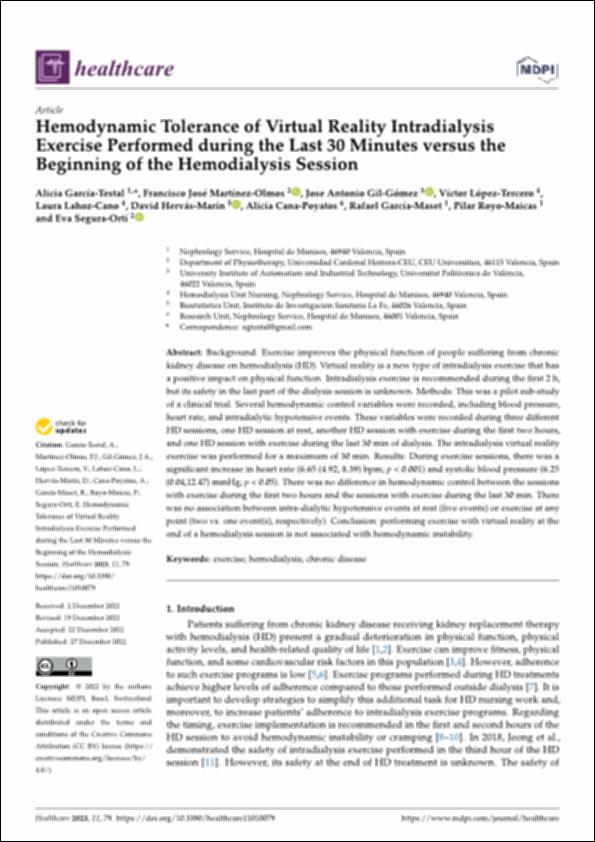Por favor, use este identificador para citar o enlazar este ítem:
http://hdl.handle.net/10637/14182Hemodynamic tolerance of virtual reality intradialysis exercise performed during the last 30 minutes versus the beginning of the hemodialysis session
| Título : | Hemodynamic tolerance of virtual reality intradialysis exercise performed during the last 30 minutes versus the beginning of the hemodialysis session |
| Autor : | García Testal, Alicia Martínez Olmos, Francisco José Gil Gómez, José Antonio López Tercero, Víctor Lahoz Cano, Laura Hervás Marín, David Segura Ortí, Eva |
| Materias: | Virtual reality.; Realidad virtual.; Ejercicio físico - Simulación por ordenador.; Fisioterapia - Innovaciones tecnológicas.; Exercise - Computer simulation.; Hemodinámica.; Hemodynamics.; Hemodiálisis.; Hemodialysis.; Physical therapy - Technological innovations. |
| Editorial : | MDPI |
| Citación : | García-Testal, A., Martínez-Olmos, F. J., Gil-Gómez, J. A., López-Tercero, V., Lahoz-Cano, L., Hervás-Marín, D. et al. (2023). Hemodynamic tolerance of virtual reality intradialysis exercise performed during the last 30 minutes versus the beginning of the hemodialysis session. Healthcare, vol. 11, i., 1 (27 dec. 2022), art. 79. DOI: https://doi.org/10.3390/healthcare11010079 |
| Resumen : | Background: Exercise improves the physical function of people suffering from chronic kidney disease on hemodialysis (HD). Virtual reality is a new type of intradialysis exercise that has a positive impact on physical function. Intradialysis exercise is recommended during the first 2 h, but its safety in the last part of the dialysis session is unknown. Methods: This was a pilot sub-study of a clinical trial. Several hemodynamic control variables were recorded, including blood pressure, heart rate, and intradialytic hypotensive events. These variables were recorded during three different HD sessions, one HD session at rest, another HD session with exercise during the first two hours, and one HD session with exercise during the last 30 min of dialysis. The intradialysis virtual reality exercise was performed for a maximum of 30 min. Results: During exercise sessions, there was a significant increase in heart rate (6.65 (4.92, 8.39) bpm; p < 0.001) and systolic blood pressure (6.25 (0.04,12.47) mmHg; p < 0.05). There was no difference in hemodynamic control between the sessions with exercise during the first two hours and the sessions with exercise during the last 30 min. There was no association between intra-dialytic hypotensive events at rest (five events) or exercise at any point (two vs. one event(s), respectively). Conclusion: performing exercise with virtual reality at the end of a hemodialysis session is not associated with hemodynamic instability. |
| Descripción : | Este artículo se encuentra disponible en la siguiente URL: https://www.mdpi.com/2227-9032/11/1/79 En este artículo de investigación también participan: Alicia Cana Poyatos, Rafael García Maset y Pilar Royo Maicas. |
| URI : | http://hdl.handle.net/10637/14182 |
| Derechos: | http://creativecommons.org/licenses/by/4.0/deed.es |
| ISSN : | 2227-9032 (Electrónico) |
| Idioma: | es |
| Fecha de publicación : | 27-dic-2022 |
| Centro : | Universidad Cardenal Herrera-CEU |
| Aparece en las colecciones: | Dpto. Enfermería y Fisioterapia |
Los ítems de DSpace están protegidos por copyright, con todos los derechos reservados, a menos que se indique lo contrario.


